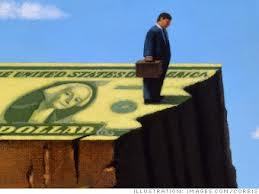Moody’s Investors Service has announced it might follow Standard & Poor’s and downgrade U.S. government debt.
S&P downgraded U.S. debt in August 2011, the first debt downgrade in U.S. government history.
In its Sept. 11 warning that it, too, might downgrade U.S. debt, Moody’s expressed concern about Congressional budget negotiations ahead of the “fiscal cliff” at the end of this year. The fiscal cliff is the term being used in finance and government circles to describe the possibility that tax cuts enacted in the early 2000s will expire, new Obamacare taxes will take effect, and big government spending cuts will occur.
Borrowing Cost Increase
A lower credit rating likely would increase the government’s borrowing costs. In its announcement, Moody’s wrote:
“Budget negotiations during the 2013 Congressional legislative session will likely determine the direction of the US government’s Aaa rating and negative outlook . . .
“If those negotiations lead to specific policies that produce a stabilization and then downward trend in the ratio of federal debt to GDP over the medium term, the rating will likely be affirmed and the outlook returned to stable, says Moody’s.
“If those negotiations fail to produce such policies, however, Moody’s would expect to lower the rating, probably to Aa1.
“Moody’s views the maintenance of the Aaa with a negative outlook into 2014 as unlikely. The only scenario that would likely lead to its temporary maintenance would be if the method adopted to achieve debt stabilization involved a large, immediate fiscal shock—such as would occur if the so-called “fiscal cliff” actually materialized—which could lead to instability. Moody’s would then need evidence that the economy could rebound from the shock before it would consider returning to a stable outlook.”
Growth or Cuts
Bill Wilson, president of Americans for Limited government, said, “Right now, although the budget deficit will be about $1.2 trillion this year, the nation’s full borrowing obligations will be more like $1.45 trillion once certain off-balance-sheet items are taken into account. However, the economy is only growing at an annualized pace of about $570 billion.
“Therefore, just to stabilize the debt-to-GDP ratio this year alone would require a full $890 billion of deficit reduction. S&P has already taken the drastic measure of eliminating the triple-A status of U.S. treasuries. Since Obama and Congress will come nowhere near to cutting $890 billion from the budget or raising that much revenue, they will undoubtedly fail to stabilize the debt-to-GDP ratio, so everyone should begin pricing in the downgrade.”
The Congressional Budget Office has laid out three possible policy scenarios.
Dubious Policy Options
Current policy, which would extend the early 2000s tax cuts, the Alternative Minimum Tax, and other provisions, would not meet Moody’s standard of a downward trend in debt-to-GDP. Publicly held debt-to-GDP would climb from 73 percent this year to 90 percent in 10 years.
Current law would allow the Bush tax cuts and other provisions to expire at the end of the year, resulting in the fiscal cliff/taxmageddon nightmare scenario most economists figure would plunge the nation into another recession. Moody’s seems to be more sanguine about this option, as the CBO predicts it would stabilize the debt at 76 percent of GDP in 2014 and then steadily reduce the debt to 58 percent of GDP by 2022.
The President’s budget is somewhere in between, though closer to the current policy scenario in terms of debt reduction. It would stabilize the debt at 80 percent of GDP in 2014 and then lower it to 76 percent of GDP by 2022. It would actually slightly increase in 2022, from 76.26 percent in 2021 to 76.33 percent in 2022. This is also an increase over the current year, so it appears the President’s budget would lead to a downgrade based on Moody’s standard.
Feeding into this is CBO’s prediction for the economy, which indicates the President’s budget would result in less economic growth in the long run than the fiscal cliff/taxmageddon scenario. In other words, the President’s budget both fails to grow the economy and fails to rein in the debt.
William McBride (wam@taxfoundation.org) is chief economist at the Tax Foundation.




